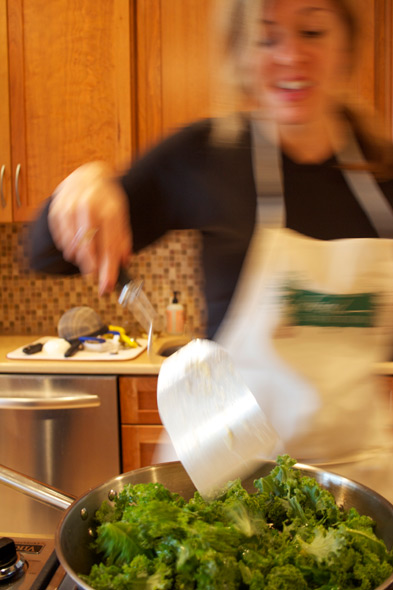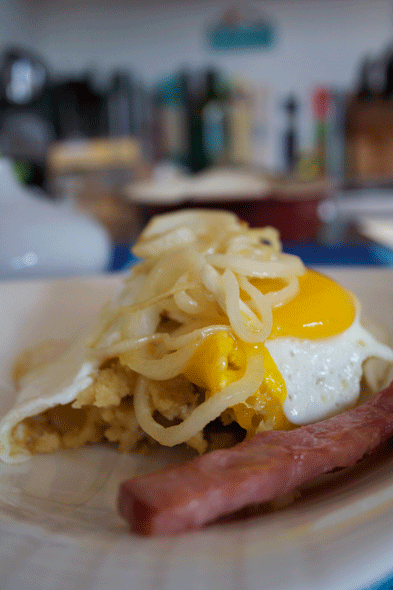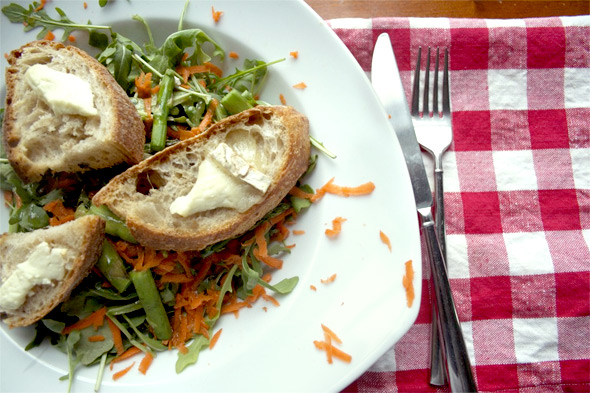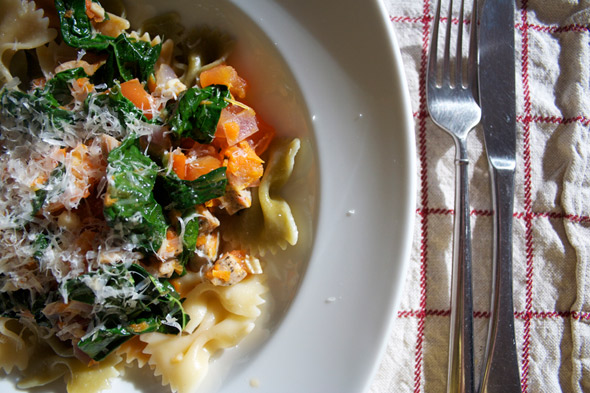Posts Tagged ‘Karina Taveras’
Easter in a bun04.16.11
Ever since we moved to Clinton, a year and a half ago, we’ve been savoring the perks of living in the heart of the city. We not only walk to work, but to a butcher shop, spice market, flea market and fishmonger all located within a 5-block radius. But one of the most treasured discoveries has been the “Chinese Bun”. Ming Du, formerly known as Ying Du, is a Chinese bakery located on 38th street and 7th Avenue, and a neighborhood goldmine. Some days, when I get my breakfast on the go, a quick stop gives me a glimpse into the early morning buzz of Chinatown. When I place my order at the counter, I always notice a devoted clientele stationed throughout the restaurant, ready to start the day with noodles, hot broth, the daily paper and sweet milk tea.
However, the main reason G and I visit Ming Du are for the assortment of their breakfast pastries. They are puffy, golden spectacles filled with red bean, pineapple, egg cream or onion scallion, making them one of the most affordable breakfasts in the city. A bun plus a small cup of tea usually sets you back about $1.35.
Which brings me to the main point of my story. Lately, I’ve been craving my habichuelas con dulce, that unique Easter dish from the Dominican Republic made from cooking red beans, coconut milk and sweet potato. With the red bean bun from Ming Du, now I can get the sweet and creamy flavors of my habichuela in a slice from the Far East right down the street.
Fresh from the market Latino!04.09.11
You must think I’m turning all health nut on you. I realize that many of my recent entries have been focusing on healthful cooking and wholesome recipes, but that doesn’t mean I’m leaving my Latin roots behind. The truth is that this semester a Consumer Journalism class at school has opened my eyes to some of the realities of our country’s food system. Coincidentally, I’ve come across some interesting articles recently that bring fresh ideas to the Latin kitchen. One of my favorite Latin food bloggers Ana Sofía Pelaez, recently wrote about the benefits of Latin American super-grains amaranth and quinoa. Lorenza Muñoz shed some light on the vegetarian options that abound in Mexican cooking in her latest story in the LA Times. more »
Organics 2.004.02.11
These days, it seems that everywhere you turn, there’s an organic counterpart to a product you’re consuming: shampoo, vegetables, dairy, even cosmetics. Their labels usually market the product as “All Natural” and “100% Organic” and are typically more expensive. But are these products worth the higher cost and most importantly, do they deliver on their claim? Keep reading to discover what you need to know to shop organics the smart way.
It’s easy to shop organic.
FALSE.
In the past few years, manufacturers have leveraged the country’s obsession with healthier eating by producing more organic products. However, for a product to have a USDA-certified organic sticker and be certified organic, it must be composed of at least 95% organic ingredients. Consumers are easily misled by those products with the word “organic” on their label, and often end up paying more for a product that has organic ingredients, but isn’t certified organic.
Diane Hoch, nutritional health counselor and founder of Food Evolution, a nutrition and cooking center in Bardonia, New York, defines the word “organic” in simple terms: “Organic is how nature intended food to be.” When shopping for produce, she suggests looking at the PLU sticker. A number 9 in front of the 4-digit number indicates the product is organic; an 8 indicates that the product has been genetically modified (yuck!).
In shopping for poultry, she recommends you look for “Free Range Organic” on the label or labeling that says “Hormone Free, Antibiotic Free” or “raised on a vegetarian diet without the use of hormones, antibiotics, steroids”. Ideally, beef should be “Grass Fed Organic” and/or purchased directly from a farm.
Organic food means more healthful food.
DEPENDS.
Organic food is food that hasn’t’ been grown using pesticides or chemical additives. It is food that doesn’t come from GMO’s (genetically modified organisms) that have been developed inside a lab, instead of in an open field. Traditionally, food was farmed in a system of rotating crops that would attract pollinators and give the earth time to replenish itself. Contemporary industrial agriculture subsists on a monoculture focused mostly on the crops of corn and soy. Thus, farmers have had to resort to using chemicals and pesticides in order to grow their crops because the earth is literally exhausted.
Virginia Schiffino, former Associate Professor of the NYU Food Studies Program, believes that organic good doesn’t equal healthful food, since now organic versions of junk food are now readily available. “I’d’ rather buy a nonorganic brussels sprouts than an organic box of cereal,” she says.
You can be eating food that’s organic that doesn’t have organic certification.
TRUE.
When you visit your local fresh market, it’s possible to buy food that’s organic without being organically certified. There are costs involved in acquiring an organic certification, so those producers whose annual sales don’t exceed $5,000 are exempted from the certification. You can often find this produce at your local farmer’s market, or at CSA’s (Community Supported Agriculture) programs, where it’s possible to visit the farm and ask the farmer directly about the kind of growing methods that are used.
Products need to be made with 100% organic materials to be labeled organic.
FALSE.
In order to be labeled organic, a product must have at least 95% organic ingredients. If it has 70%, the product can be labeled as “made with organic ingredients”. The National Organic Program (NOP) is the federal regulatory agency governing organic food, administered by the USDA. The Organic Food Production Act of 1990 required the USDA develop national standards for organic products, which covers production, processing, delivery and sale of organic products.
When a product is not organic, you can automatically assume that it has some GMO components.
TRUE.
GMO’s are genetically modified organisms that have been altered or developed inside a lab. Food that is not certified organic has at least some traces of GMO’s. High fructose corn syrup and hydrogenated oils are examples of GMO’s that are commonly found in most of today’s processed foods. To Schiffino, what is more perplexing is that fact that when something is not organically certified, you don’t know why it’s not. “When something is certified, it’s absolutely clear, but when not, the consumer is lacking in a lot of information,” she says. There are parts of the world in which more transparency exists when it comes to what’s in your food. In Europe, for example, labeling requirements specify that manufactures have to let consumers know the ingredients that are GMO’s.
You should stay away from the “Dirty Dozen” to reduce pesticides in your diet.
TRUE.
There’s a list of produce that is more prone to absorbing pesticides because of its soft outer layer. These fruits and vegetables have been labeled the “Dirty Dozen”, which include the following:
Celery
Peaches
Strawberries
Apples
Domestic blueberries
Nectarines
Sweet bell peppers
Spinach, kale and collard greens
Cherries
Potatoes
Imported grapes
Lettuce
Source: Environmental Working Group 2010
Jessica Solt, a writer in New York City has been shopping organic for about 1 ½ years. Her wake-up call came after watching the movie Food, Inc, which led her to realize that the food industry was “being tampered with”. For her, it’s money that’s well spent. “If there’s something you can control, it’s that.”
So next time you prepare your sofrito, try to make it with organic celery instead.
Magnificent Mangú03.09.11
For me, weekends are for sleeping in, seeing friends, catching up on life and most importantly, indulging in the luxury of time. Creating elaborate breakfast dishes is such a treat that I sometimes enjoy the process more than the actual tasting (ahem, NOT). Mangú con huevo, the quintessential breakfast dish from the Dominican Republic is the perfect case in point. Mangú, or mashed green plantains, is made by boiling green plantains and crushing them with olive oil and butter until they’re soft and creamy. In the D.R., mangú is typically served with fried cheese, fried salami (a local sausage), sunny side eggs and avocado. The end result is a feast of textures: the smoothness of the egg yolk balances the density of the plantain, the cheese and salami add a salty crisp and the avocado a cool refuge for your taste buds.
As I prepared this beloved breakfast dish on a recent Saturday, I was reminded of a drive I took with the family through the Dominican countryside, as we made our way to the mountains of Jarabacoa. The morning was rainy and fresh, and we stopped at the breezy roadside restaurant Típico Bonao which lures locals from all over the country to start the day with this dish and an aromatic cup of Dominican coffee. Mangú con huevo brings back this Dominican love, and nourishes the spirit as well as the belly.
Mangú con Huevo Serves 2
2 green plantains
olive oil
butter
salt
red onion
white vinegar
4 eggs
breakfast ham
“queso de hoja” cheese (optional)
avocado (optional)
Chop the ends off each plantain. Make slits throughout the plantain, running the tip of your knife through the length of the fruit. Chop the plantains into 1″ chunks. Fill a pot with water and boil the plantain chunks for about 45 minutes.
While the plantains cook, thinly slice the onion and place the slivers in a bowl with 1 tablespoons of white vinegar, olive oil and salt. Stir these around until the onion gets covered and let it rest.
Check if the plantains are ready by piercing them with a fork. They should be tender when cooked. They will also be easy to peel. Remove their skin and place the chunks in a deep bowl. Pour a 1/4 cup of cooking liquid, a drizzle of olive oil, 1 tablespoon of butter and salt and start to mash with a masher or fork. Work through the pieces, alternating with the liquid, olive oil and butter, until you achieve your desired consistency.
Working quickly, pan fry the onions in a drizzle of olive oil and pour over the mangú. Cover with aluminum foil to keep warm. Next toss the ham, and fry the eggs sunny side up, on a non-stick pan. You can also deep fry the queso de hoja for an authentic latin kick and slice up some avocados on the side. Serve the mangú with the onions, eggs and ham. Eat immediately!
“The sky is clear, prepare yourself for warmth”02.06.11
It’s 40 degrees in New York City today! The sky is a bright blue, sunlight is flooding my living room and it feels like Spring is actually peeking its head. Oh, sun, how I have missed you! After weeks and weeks of gloom and gray, it’s refreshing to see that buildings outside my window actually have color: red, sand, white, yellow. This week, Punxsutawney Phil predicted an early Spring. Only two more weeks of winter? I can’t wait! And even if it takes a little longer to arrive, it’s not too early to kick off Spring, at least in our kitchens. Here’s a clean Paris-inspired recipe that’s bright on your plate and good for you, too.
Salade de Chèvre Chaude (warm goat cheese salad)
Makes 2 servings
Salad green (mesclun, spinach or romaine)
2 carrots shredded
any other veggies that turn you on or you have in your kitchen
rustic bread
goat cheese
Dressing
1 shallot finely diced
2 tablespoons of olive oil
1 tablespoon of red wine vinegar
1 teaspoon of Dijon mustard
salt
pepper
sugar
Combine dressing ingredients and adjust seasonings to your liking with salt, pepper and sugar. Set aside. Toast the bread. Top the slices of bread with goat cheese and stick in the broiler for 2 minutes or until cheese is bubbly and soft. Toss salad greens and veggies with the dressing. Top your salad with the toasted bread and cheese. Eat immediately!
The Clean Experiment01.23.11
I’m on a roll. The past week and half, I’ve dedicated myself to cooking and eating “clean”. I figured, it’s the beginning of the year, perfect time to establish new habits, so why not try something different? I was inspired by Clean, a book by Alejandro Junger M.D. (viva Uruguay!), that crossed my path on January 1st (was this a sign or what?). The book focuses on a detox program that promises to heal and clean your body. But it also gives an in-depth explanation about toxins and practical advice to decrease exposure to them in a very clear and descriptive way.
When it comes to detoxes and cleansing, I’m your #1 skeptic. I believe that the body is intelligent enough to activate its natural cleansing functions so I was a little hesitant to even pick up the book. But when my friend JP told me it was written by a fellow Hispanic, I figured I should give him chance. Well, looks like I’m almost done with the book and I’m still not sold on the detox program. Yet, the one thing it has definitely done for me is build my awareness.
As an experiment, I spent the last 10 days cooking as clean and simply as possible, focusing on whole foods whenever possible and going back to basics: lots of fruits and veggies, more seeds and nuts, less animal products, more water. Immediately I noticed a huge difference in my energy. Not only did it soar, but I felt very balanced, both emotionally and physically. I haven’t really deprived myself of anything ( I had some Baklava for dessert!), just have paid more attention on preparing more simple and nourishing foods.
This conscious way of nourishing myself has made me more creative in the kitchen, too. This week, I made everything from roasted beet and carrot salad with thyme and goat cheese to an Italian-inspired kale and white bean soup. I’m devoting myself to the Clean Experiment for the next few weeks. Throughout my journey, I plan to share with you some of the best recipes I come across, in hopes that you too can restore your energy and balance. Happy cooking!
Crazy Veggie Toss Serves 4
1 bunch of Tuscan kale
1 tomato cubed
1 red onion cubed
2 carrots grated
3 cloves garlic minced
2 tablespoons olive oil
Herbs: could be thyme, rosemary, or cilantro for a latin kick (get creative!)
Salt
2-3 Sausage (I used a sun-dried tomato and rosemary chicken sausage from Whole Foods) cubed
Parmesan cheese
Stem and devein the kale. Roughly chop and rinse with cold water. Warm the olive oil in a deep pan, add the onion and carrots and heat until soft. Add the sausage and cook until browned. Add the garlic and tomato and cook until soft. Taste for salt. Add the herbs and the kale. Add a splash of liquid (water, broth, wine) until the mixture acquires your desired consistency. Cook for 20-30 minutes. Serve over pasta, chicken or a filet of grilled fish. Top with some grated parmesan cheese. If you want to make it veggie-friendly, just omit the sausage. ¡A tu salud!
An End, but also a Beginning01.07.11
As a little girl, I looked forward to the Three Kings Day, traditionally celebrated on January 6th of every year. Another day to get presents? Sign me up. The present was always something small-un cariñito-but I knew that after Santa came and left I still had something to look forward to. Back at home in Santo Domingo, this day marked the official end of the holiday season. Mom would finally take down the tree, we would return to school and normal life would resume.
Yet those memories of the Día de los Reyes have stayed with me throughout the years. On the eve of January 6th, my sister and I would leave three small glasses of whiskey (or whatever liquor was at hand in the house) for the “three kings” and a fistful of grass to “feed the camels”. The next morning, we would run to front door and find not only our little gifts, but three empty glasses and, surprise, the grass that we had left for the camels was gone! It was like magic.
So this day, at least in my book, marks an end, but it also signifies a beginning. I wish you all a very sweet year ahead. May all of your dreams become reality and may you rediscover, as I did, a hint of the innocence and wonder that makes everything in life, seem possible.
My Top 10 list for an NYC holiday12.17.10
This year, I’ll be celebrating a tropical holiday. After six years in NYC, G and I decided to change things up a bit and follow the sun this year. We have gotten a beating the past few weeks with temperatures in the 20’s, so I’m looking forward to shaking off the cold for a couple of days.
I have to admit there’s something very special about celebrating the holidays in a winter wonderland (especially when the snow starts to fall). So I’ve compiled a list of the top 10 things (food-related, of course) that I will miss about having an NYC holiday.
In the meantime, I hope you have a happy, blessed week with many new discoveries, wherever the holidays find you.
My Top 10 for an NYC Holiday
10. Shopping in the charming outdoor Holiday markets and noshing on cool snacks like olive and feta cheese pretzels (Columbus Circle), almond and sage cookies (Union Square) and Max Brenner’s hot chocolate (Bryant Park).
9. A piping hot bowl of Vietnamese Phó shared with a group of loud and crazy friends over Sunday supper.
8. Early dinners of steamy Halal platters with delicate strips of lamb, the lightest rice on earth and an out of this world yogurt sauce to marry all the ingredients together.
7. Indulging in holiday drinks like “Dominican egg-nog” and after going out for a late-night walk in the cold while feeling warm and fuzzy.
6. Rediscovering the pleasure of drinking tea by tossing aside the familiar and experimenting with flavors like elderflower green tea, gen mai cha and South African rooibos in TeaGschwendner, my new favorite tea shop.
5. Getting creative in the kitchen with squash, brussel sprouts and all the fall produce!
4. Preparing steamy soups that nourish the spirit and warm the belly in my beloved blue pot .
3. A dinner of lemony avgolemono from Uncle Nick’s, our neighborhood Greek spot.
2. Picnic lunches in the office with fresh baguettes, thin veils of prosciutto, fresh and creamy mozzarella, fig jam and green salad, all from quick runs to Eat-aly!
and the number one thing I will miss about spending my holidays in NYC is:
Eating ice-cream when it’s 20 degrees outside ’cause it means you can take your sweet time and really savor every bite!
Brandy Alexander, it goes down easy12.12.10
I was on a mission to find “Latinized” versions of holiday drinks, like the egg nog and mulled cider that now abound in outdoor market around the city. And I found them. In the December issue of the Food Network magazine, a handy guide perfect for adding to your off-line recipe collection featured how-to’s for Hot Dulce de Leche, Mexican Hot Chocolate and Coconut Nog, as well as festive concoctions perfect for warming us up from the inside out (ei. maple chai) and getting us into the spirit with a little bubbly (ei. kir royale).
But this week, as I read through Melissa Clark’s rediscovery of eggnog in the New York Times, I remembered the holiday traditions of my life back home. Along with an arduous fruit cake production that would tie up the kitchen for days, Mom would always be ready to prepare her own decadent interpretation of one of her favorite drinks, the Brandy Alexander. She whipped up this creamy elixir every time she was ready to entertain (which was almost daily). With exuberant gusto she combined condensed milk, evaporated milk, white rum and crème de cacao, blended it with ice and poured the frosty mixture into delicate rose-colored goblets, topping each glass with a sprinkle of cinnamon. The result was a dreamy, creamy drink that is (almost) worthy of replacing dessert. As Feist best puts it in her song, this drink definitely “goes down easy”.
This holiday I invite you to make a batch, bottle it up and give it away as homemade gifts. Or keep it, invite your favorite people over for a drink and celebrate how sweet life can be.
Cora’s Brandy Alexander
1 ½ cans of condensed milk
2 ½ cans of evaporated milk
1 can of white rum
1 can of crème de cacao (or your favorite chocolate liqueur)
powdered cinnamon and/or cinnamon stick
note: use one of the empty cans to measure the rum and liqueur
Whisk all the ingredients together in a large bowl. Blend with ice or mix in a cocktail shaker. You can also serve without the ice. Top with cinnamon. Enjoy!










Food For Thought